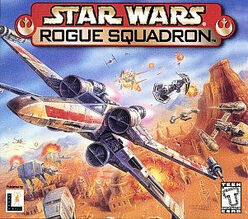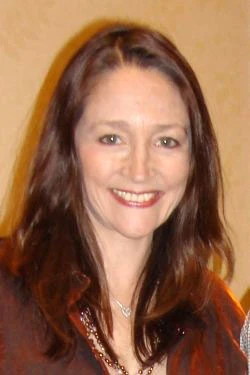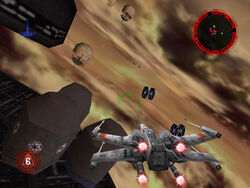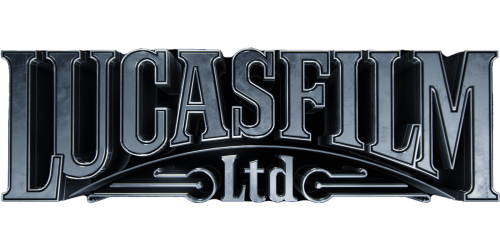| Star Wars: Rogue Squadron | |
|---|---|

| |
| Developed by: | Factor 5 LucasArts |
| Published by: | Script error: No such module "collapsible list". |
| Genre(s): | Action, Shooter |
Star Wars: Rogue Squadron (known as Star Wars: Rogue Squadron 3D on the PC) is an arcade-style action game co-developed by Factor 5 and LucasArts. The first of three games in the Rogue Squadron series, it was published by LucasArts and Nintendo and released for Windows and the Nintendo 64 in December 1998. Rogue Squadron was one of the first games to take advantage of the Nintendo 64's Expansion Pak, which allows gameplay at a 640 × 480 display resolution, instead of that system's standard 320 × 240 resolution.
Set in the fictional Star Wars galaxy and inspired by the Star Wars: X-wing Rogue Squadron comics, the game takes place primarily between events in the films Star Wars and The Empire Strikes Back. The player controls Luke Skywalker, commander of the elite X-wing pilots known as Rogue Squadron. As the game progresses, Skywalker and Rogue Squadron fight the Galactic Empire in sixteen missions across various planets.
Rogue Squadron received generally positive reviews. Critics praised the game's technical achievements and flight controls, but its use of distance fog and the lack of a multiplayer mode drew criticism. The game's sales exceeded expectations; by August 1999, more than one million copies had sold worldwide. It spawned two sequels developed and released for the Nintendo GameCube—Star Wars Rogue Squadron II: Rogue Leader and Star Wars Rogue Squadron III: Rebel Strike—as well as Star Wars: Episode I: Battle for Naboo, a spiritual successor released for Windows and Nintendo 64.
Gameplay[]
Unlike the Star Wars: X-Wing computer game series that emphasizes space combat simulation, Rogue Squadron is a fast-paced, arcade-style action game.[1] Each of the game's sixteen levels introduces mission objectives that must be completed to progress to the next level. These objectives are divided into four categories: search and destroy, reconnaissance, rescue and protect.[2] Enemy aircraft are primarily composed of TIE fighters. Ground defenses are more varied and include three different walkers, laser and missile turrets, tanks, probe droids, shuttles, stormtroopers and speeder bikes.[3]
The heads-up display features a health meter, a radar and an ammunition count for secondary weapons.[4] The player can control five craft: X-wing, A-wing, Y-wing, snowspeeder and V-wing.[5] Each vehicle offers a unique armament arrangement, as well as varying degrees of speed and maneuverability.[6] The game initially restricts the player to a particular craft for each level; however, after a level is completed, it can be replayed with any available craft.[7] Levels set on non-atmospheric moons expose the player's craft to space; thus disallowing the Speeder and V-Wing (which are repulsorcraft) from being used; but as on other levels, the craft is vertically confined.[2] Nine bonus power-ups are hidden in different levels throughout the game. These bonuses improve a craft's weapons or durability and are applied to each eligible craft for the remainder of the game.[6]
The player's performance is measured throughout the game, and performance statistics are checked after each level against three medal benchmarks. Each benchmark contains five categories: completion time, number of enemies destroyed, shot accuracy, number of friendly craft and structures saved and number of bonuses collected. If a player's performance exceeds one of the level's three benchmarks in all five categories, a medal—bronze, silver or gold—is awarded on completion. Acquiring these medals promotes the player's rank and helps unlock hidden content.[8]
Unlockable content[]
Rogue Squadron includes a number of unlockable secrets. The player can unlock three bonus levels: "Beggar's Canyon", "The Death Star Trench Run" and "The Battle of Hoth". These levels are made available when the player obtains all bronze, silver or gold medals, respectively, on each level. Alternatively, they can be unlocked via password. Unlike the game's primary levels, the bonus levels are adaptions of events from the Star Wars films. "Beggar's Canyon" allows the player to reenact the race mentioned in A New Hope, while "The Death Star Trench Run" allows the player to execute an alternate version of the movie's climactic battle. In the "Battle of Hoth" bonus level, the player can join the Rebel Alliance's combat against Imperial troops, as depicted in The Empire Strikes Back.[9]
Several craft are also available when unlocked. Both the Millennium Falcon and a TIE interceptor are initially present in the craft selection screen. However, neither may be selected until the player enters the correct passwords or achieves all bronze or silver medals, respectively, on the bonus levels. Two other craft can be unlocked, but each is confined to a specific level. One is the T-16 Skyhopper in "Beggar's Canyon", and an AT-ST is playable in a basic demonstration level unlocked only via password. A playable model of a 1969 Buick Electra 225 based on a car owned by the game's sound designer, Rudolph Stember, is also included in the game as an Easter egg.[9]
During Rogue Squadron's development, Star Wars Episode I: The Phantom Menace—the first new Star Wars film in more than 15 years—was less than one year from its scheduled release date. To take advantage of this marketing opportunity, Factor 5 included content from the upcoming film in Rogue Squadron. LucasFilm provided the developers with design art for the Naboo Starfighter, a ship prominently featured in the new film. These designs were used to create an in-game model. Because the game was scheduled to be released six months before the film, Factor 5 was required to keep the ship's inclusion a secret. As a result, most of the game's development team at Factor 5 and LucasArts were not informed of its inclusion.[10] A complex scrambling system was also developed to help hide the ship's code from gamers using game-altering devices such as GameShark or ProAction Replay. More than six months after the release of Rogue Squadron, LucasArts unveiled the code to unlock the Naboo Starfighter as a playable craft. The code has been named the Nintendo 64's most well-hidden code because of the length of time before its discovery.[9]
Synopsis[]
Setting[]
Star Wars: Rogue Squadron is set in the fictional Star Wars galaxy, where a war is fought between the Galactic Empire and the Rebel Alliance. The game's first fifteen levels occur six months after the Battle of Yavin—as depicted in Star Wars Episode IV: A New Hope—and before the events of Star Wars Episode V: The Empire Strikes Back. As the Empire gathers strength for an all-out assault on the rebel forces, Luke Skywalker and Wedge Antilles form Rogue Squadron, a group comprising twelve of the most skilled X-wing pilots from the Rebel Alliance.[11]
The sixteenth and final level of the game takes place during Dark Empire, six years after Star Wars Episode VI: Return of the Jedi's Battle of Endor. The Rebel Alliance has established the New Republic, which now controls three quarters of the galaxy. After the deaths of Darth Sidious and Darth Vader, the Galactic Empire collapsed, but was reborn under a mysterious new leader (who is actually a clone of Darth Sidious). Rogue Squadron, now under the command of Wedge Antilles, continues to fight the Empire to protect the newly formed Republic.[12]
Plot[]
The story is divided into four chapters, each of which starts with an opening crawl resembling those featured in the Star Wars films. Further story details are presented through the game's instruction manual, pre-mission briefings, character conversations during the game and in-game cut scenes. The game begins with Rogue Squadron briefly encountering the Empire at the Mos Eisley spaceport on Tatooine. The team then executes escort and rescue missions on Barkhesh and Chorax, respectively.[13]

Screen actor Olivia Hussey provided voice work for Kasan Moor.
The Rebels learn that Imperial officer Crix Madine wishes to defect to the Rebel Alliance.[14] The Empire launches an attack on Corellia, where Madine is stationed, to prevent his departure.[15] Rogue Squadron, with the help of Han Solo and Chewbacca in the Millennium Falcon, fights off the Empire and helps escort Madine safely off the planet. Soon after, Rogue Squadron is joined by Gold Squadron, a group of Y-wings now led by Crix Madine; they are dispatched to the moon of Gerrard V to aid its quest for independence from the Empire.[16] They encounter the 128th TIE interceptor Squadron and disable Kasan Moor's TIE.[17][18] When Rogue Squadron tells Moor that she has been taken prisoner, she offers to defect and provide the Rebel Alliance with Imperial intelligence.[19]
With the help of Kasan Moor's intelligence, the Alliance launches three consecutive attacks on Imperial bases throughout the galaxy. After an assault on the Imperial Enclave, a facility on Kile II supporting the Empire's Naval operations, Wedge Antilles is ambushed by a group of TIEs and is taken captive.[20][21] The Rebel Alliance tracks Wedge to an Imperial prison complex on the planet of Kessel.[22] The remaining members of Rogue Squadron travel to Kessel and rescue him and other Rebel prisoners.[13]
With Wedge Antilles free and Rogue Squadron again at full strength, the Rebel Alliance turns its attention to a new Imperial threat — Moff Kohl Seerdon. Seerdon is consolidating Imperial power in preparation for an attack aimed at capturing Thyferra, a planet which produces the healing substance bacta. Rogue Squadron is ordered to disrupt his operation with hit-and-run missions against key targets on Taloraan and Fest.[23] In retaliation, Seerdon attacks and holds a city on the planet of Chandrila hostage.[24] Rogue Squadron and the Alliance strike back by initiating a Kasan Moor-engineered raid on an Imperial base located inside a volcano on Sullust.[25] While still on Sullust, however, General Rieekan informs the Squadron that Moff Seerdon has used their raid as a diversion and begun his attack on Thyferra.[26] With Seerdon in control of the planet's bacta and their own supply threatened, Rogue Squadron quickly reaches Thyferra, kills Seerdon and frees the planet.[13]
In the final chapter, the game moves into the future, six years after the Battle of Endor. Rogue Squadron, now under the command of Wedge Antilles, continues to fight the wounded Empire. On the planet of Mon Calamari, new Imperial weapons called World Devastators are destroying the planet.[12] Rogue Squadron is deployed, disables all three Devastators and destroys the Imperial presence.[13]
Development[]
After the success of Shadows of the Empire on the Nintendo 64 in 1996, LucasArts began planning a follow-up. At the time, Factor 5 was developing a game engine to create large terrain maps. LucasArts, pleased with earlier collaborations with the company, decided to use Factor 5's engine for its new game.[10] The game's focus would be space combat; this direction was inspired by a level of Shadows of the Empire in which the player flies a snowspeeder during the Battle of Hoth. Rogue Squadron and Factor 5 production manager Brett Tosti stated, "That whole scene was actually the genesis for Rogue Squadron because everybody said, 'Why don't you do a whole game like that?' So we did."[27] Factor 5 initially pitched a concept to allow gamers to play through missions similar to the fans' favorite action sequences from the Star Wars films. This proposal was rejected, however. At that time, LucasFilm was not comfortable with video games drawing directly from the films.[10]

The Nintendo 64's Expansion Pak allows gameplay at a higher resolution.
During the early stages of development, the designers at LucasArts[28] were inspired by Rogue Squadron and later Star Wars: X-wing Rogue Squadron, a series of books and comic books set during the years of the original film trilogy. They began developing the story and gameplay [29]with a similar setting that would include characters from the films participating in new, original missions using Factor 5's terrain map engine as the base. In May 1998, a demo of the game was displayed at E3, but the game was so incomplete at the time that Tosti considered it a tech demo. It rendered a basic heightmap and an immobile AT-AT model, while TIE fighters lacking artificial intelligence flew and fired in a predetermined path. When "playing" the demo for audiences, Tosti followed a very specific flight path of his own to give the illusion that he was actually battling with the TIEs. Despite the demo's barebones presentation, response from gamers was largely positive.[10]
Factor 5 appealed to Nintendo to use the Nintendo 64's newly developed memory Expansion Pak. Nintendo was reluctant, expecting the technology to be reserved solely for hardware peripherals. However, after Iguana Entertainment used the Expansion Pak to achieve a higher display resolution for Turok 2: Seeds of Evil, Factor 5 was given the green light. The Expansion Pak is used to increase Rogue Squadron's N64 resolution from 320 × 240 to 640 × 480.[2][10]
LucasFilm was hesitant to grant access to the Star Wars library of sound effects for the game's sound designer, Rudolph Stember. As a compromise, the company provided Stember with sounds sampled at the relatively low rate of 22 kHz, half the standard rate. Stember objected, claiming that the clips sounded worse than effects he had lifted from VHS tapes for a previous Star Wars project.[10] The game includes voice work from several notable persons, including screen actors Olivia Hussey and Raphael Sbarge as well as voice actors Bob Bergen, Neil Ross and Terence McGovern.[30] Instead of using Nintendo's default sound drivers, Factor 5 developed its own tool called MOsys FX Surround. The Factor 5 drivers use Nintendo 64 processors, but tax them less; advanced compression techniques were also employed. As a result, the game includes over 80 minutes of high-quality stereo sound.[31][32]
In November 1998, a month before the game's scheduled release, LucasArts signed a worldwide agreement with Nintendo concerning three new Star Wars video games. It granted Nintendo the rights to market the games and hold exclusive, worldwide distribution rights for five years following each release. Rogue Squadron was the first game released under this agreement.[33]
Reception[]
| Reception | ||||||||||||||||||||||||||||||||||||||||||||||||||||||||||||||||||||||||||||||||||||||||||||||||||||||||||
|---|---|---|---|---|---|---|---|---|---|---|---|---|---|---|---|---|---|---|---|---|---|---|---|---|---|---|---|---|---|---|---|---|---|---|---|---|---|---|---|---|---|---|---|---|---|---|---|---|---|---|---|---|---|---|---|---|---|---|---|---|---|---|---|---|---|---|---|---|---|---|---|---|---|---|---|---|---|---|---|---|---|---|---|---|---|---|---|---|---|---|---|---|---|---|---|---|---|---|---|---|---|---|---|---|---|---|
| ||||||||||||||||||||||||||||||||||||||||||||||||||||||||||||||||||||||||||||||||||||||||||||||||||||||||||
| ||||||||||||||||||||||||||||||||||||||||||||||||||||||||||||||||||||||||||||||||||||||||||||||||||||||||||

The R2 unit and exhaust flames on the player's X-wing are examples of graphical detail that were praised by reviewers.
Many reviews compared Star Wars: Rogue Squadron to one of its inspirations, the Battle of Hoth flight combat level in Shadows of the Empire, considered one of that game's best elements.[2][37] GamePro remarked that Rogue Squadron "enhanced the flight model with true pitch, roll, and bank mechanics".[31] IGN praised its inclusion of "upgrades, more enemies, better sound, and stunning second-generation graphics".[2] The Nintendo 64 version received mostly positive reviews, and received an aggregate score of 85 percent from both GameRankings and Metacritic.[40][43] GamePro named it one of the best games released in 1998.[31] In a 2008 retrospective, IGN's Levi Buchanan stated that the game revived the Star Wars license on consoles through well-paced gameplay, a story tied into the Star Wars canon and visuals that made it "one of the generation's top stunners".[45]
The game's technical aspects were singled out for acclaim. Its visuals were called "respectable"[2] in the standard resolution, but highly praised in high-resolution mode (achieved via the Nintendo 64's Expansion Pak). GameSpot remarked that in a higher resolution, "[the] textures of the landscapes, the ships, the lighting effects—everything looks so much better,"[37] while IGN's Peer Schneider said, "After playing the game in the optional high resolution mode (640 × 480) once, it's impossible to go back to the still respectable standard resolution." Citing details such as decals, Rebel markings, R2 units, cockpit views and exhaust flames, Schneider described the game's 3D ship models as "gorgeous". IGN's Matt Casamassina said that the game was the best-looking Nintendo 64 game to date.[2]
Reviewers also praised the game's sound design. Powered by the new Factor 5 audio drivers, Rogue Squadron features about 40 minutes of speech and 40 minutes of music.[31] GameSpot's Ryan Mac Donald believed that the game's inclusion of extended voice work helped create a "movie-like" atmosphere.[37] IGN noted that in addition to being technically impressive, the game's Dolby Pro Logic surround sound was an important gameplay element. The audio signals helped players determine enemy positions and direction of travel. IGN awarded the game three sound awards, including Sound Effects, Best Voice and Best Overall Sound of 1998 on the Nintendo 64.[32]
Some reviewers complained about aspects of the game's visuals; critics disliked the heavy reliance on distance fog.[2][37] Another common criticism of the game was the lack of multiplayer modes. GameProTemplate:'s review called the omission a "serious, unforgivable sin";[31] Schneider believed that while adding these modes would have extended Rogue SquadronTemplate:'s replay value, the game was still enjoyable for its medal reward system and large number of secrets and unlockables.[2]
Although nearly identical,[35] the game's PC version garnered lower review scores than its Nintendo 64 counterpart, with an aggregated GameRankings score of 80 percent.[42] This version enjoyed many of the same praises for its gameplay,[39] but handling and graphics were cited as problematic. Directly comparing the two versions, Allgame's Brad Cook wrote that PC version's handling is more difficult than the N64 version. He believed the PC's "choppy" feel made it difficult to target enemies.[35] In contrast to its opinion of the N64 version, IGN's PC review was not enthusiastic about the game's visuals. IGN staff remarked that Rogue Squadron's "graphics and special effects aren't spectacular" and that they had "seen better graphics" on the PC.[39]
Sales[]
When Rogue Squadron was released in early December 1998, the title's Nintendo 64 incarnation was the second-highest-selling video game for the first half of the month (behind Nintendo's The Legend of Zelda: Ocarina of Time)[46] and the holiday season.[47] Delayed until after Christmas in the United Kingdom, the game was released mid-January and debuted as the second-best-selling game of the month, ahead of Ocarina of Time.[48] In August 1999, Nintendo added the title to its best-selling Player's Choice collection,[49] while the PC version was re-released as a part of the LucasArts Archive Series in May 2001.[50] Rogue Squadron's retail success was not anticipated by the game's producer Julian Eggebrecht, who said that the game sold "about 100 times better than anybody expected".[10] The Nintendo 64 version sold over 1 million copies in the United States,[51] and over 44,000 in Japan.[52]
References[]
- ↑ 1.0 1.1 Don St. John (November 24, 2000). Star Wars: Rogue Squadron 3D. GamePro. Archived from the original on December 10, 2008. Retrieved on October 28, 2008.
- ↑ 2.0 2.1 2.2 2.3 2.4 2.5 2.6 2.7 2.8 2.9 Cite error: Invalid
<ref>tag; no text was provided for refs namedIGN N64 review - ↑ Cross, Victor; Boero, Mollie (1998). "Imperial Craft and Defenses", Star Wars: Rogue Squadron (manual). LucasArts, 17–19.
- ↑ Cross, Victor; Boero, Mollie (1998). "In-flight Controls", Star Wars: Rogue Squadron (manual). LucasArts, 11–12.
- ↑ Cross, Victor; Boero, Mollie (1998). "Player Craft", Star Wars: Rogue Squadron (manual). LucasArts, 14–15.
- ↑ 6.0 6.1 Cross, Victor; Boero, Mollie (1998). "Craft Armament", Star Wars: Rogue Squadron (manual). LucasArts, 15.
- ↑ Cross, Victor; Boero, Mollie (1998). "Getting Started", Star Wars: Rogue Squadron (manual). LucasArts, 9.
- ↑ Cross, Victor; Boero, Mollie (1998). "Scoring", Star Wars: Rogue Squadron (manual). LucasArts, 19.
- ↑ 9.0 9.1 9.2 The Secrets of Rogue Squadron. IGN (July 19, 1999). Retrieved on November 2, 2008.
- ↑ 10.0 10.1 10.2 10.3 10.4 10.5 10.6 Shoemaker, Brad. Star Wars Rogue Squadron: A Retrospective. GameSpot. Retrieved on October 30, 2008.
- ↑ Cross, Victor; Boero, Mollie (1998). "Overview", Star Wars: Rogue Squadron (manual). LucasArts, 2.
- ↑ 12.0 12.1 Template:Cite video game
- ↑ 13.0 13.1 13.2 13.3 Template:Cite video game
- ↑ Template:Cite video game
- ↑ Template:Cite video game
- ↑ Template:Cite video game
- ↑ Template:Cite video game
- ↑ Template:Cite video game
- ↑ Template:Cite video game
- ↑ Cross, Victor; Boero, Mollie (1998). "Overview", Star Wars: Rogue Squadron (manual). LucasArts, 22.
- ↑ Template:Cite video game
- ↑ Template:Cite video game
- ↑ Template:Cite video game
- ↑ Template:Cite video game
- ↑ Template:Cite video game
- ↑ Template:Cite video game
- ↑ E3: The Big Rogue Leader Interview. IGN (May 17, 2001). Retrieved on October 30, 2008.
- ↑ Star Wars Rogue Squadron: Credits. MobyGames. Retrieved on December 7, 1998.
- ↑ LucasArts Level Designers Interview. theforce.net. Retrieved on May 7, 2000.
- ↑ Game Credits for Star Wars: Rogue Squadron 3D. MobyGames. Retrieved on December 30, 2008.
- ↑ 31.0 31.1 31.2 31.3 31.4 31.5 Scary Larry (November 24, 2000). Rogue Squadron. GamePro. IDG Entertainment. Archived from the original on December 10, 2008. Retrieved on October 28, 2008.
- ↑ 32.0 32.1 32.2 Best Sound of 1998. IGN (February 5, 1999). Retrieved on November 4, 2008.
- ↑ Nintendo, LucasArts Announce Limited Exclusive Star Wars Deal for Video Game Systems; Nintendo Granted Worldwide Distribution for Five Years. Business Wire (November 3, 1998). Retrieved on February 5, 2009.
- ↑ Marriott, Scott Alan. Star Wars: Rogue Squadron. Allgame. Retrieved on October 28, 2008.
- ↑ 35.0 35.1 35.2 Cook, Brad. Star Wars: Rogue Squadron 3D. Allgame. Retrieved on October 28, 2008.
- ↑ ニンテンドウ64 - スター・ウォーズ出撃!ローグ中隊. Weekly Famitsu. No.915 Pt.2. Pg.28. 30 June 2006.
- ↑ 37.0 37.1 37.2 37.3 37.4 Mac Donald, Ryan (December 11, 1998). Star Wars: Rogue Squadron Review. GameSpot. Retrieved on October 28, 2008.
- ↑ Chin, Elliot (December 11, 1998). Star Wars: Rogue Squadron 3D Review. GameSpot. Retrieved on October 28, 2008.
- ↑ 39.0 39.1 39.2 Cite error: Invalid
<ref>tag; no text was provided for refs namedIGN PC review - ↑ 40.0 40.1 40.2 Star Wars: Rogue Squadron. GameRankings. Retrieved on July 9, 2009.
- ↑ Star Wars: Rogue Squadron 3D. PC Zone. Future Publishing (August 13, 2001). Retrieved on November 4, 2008. Template:Dead link
- ↑ 42.0 42.1 Star Wars: Rogue Squadron 3D. GameRankings. Retrieved on July 9, 2009.
- ↑ 43.0 43.1 Star Wars: Rogue Squadron. Metacritic. Retrieved on October 28, 2008.
- ↑ 1998 – Academy of Adventure Gaming Arts and Design. Academy of Adventure Gaming Arts and Design. Archived from the original on July 10, 2008. Retrieved on October 22, 2008.
- ↑ Nintendo 64 Week: Day Three. IGN (October 1, 2008). Retrieved on November 12, 2008.
- ↑ Zelda and Star Wars Take Over USA Top 10. IGN (January 8, 1999). Retrieved on November 12, 2008.
- ↑ N64 Titles Dominate Holiday Season. IGN (January 18, 1999). Retrieved on November 12, 2008.
- ↑ Rogue Squadron Lands in the UK. IGN (January 26, 1999). Retrieved on November 12, 2008.
- ↑ Buy Hyrule at Bargain Price. IGN (January 18, 1999). Retrieved on January 9, 2009.
- ↑ Couper, Chris. Star Wars: Rogue Squadron 3D – LucasArts Archive Series. Allgame. Retrieved on July 17, 2009.
- ↑ Satterfield, Shane (May 17, 2001). E3 2001: Hands-on Rogue Leader: Rogue Squadron II. GameSpot. Retrieved on August 9, 2009.
- ↑ Nintendo 64 Japanese Ranking. Famitsu. Japan Game Charts (April 10, 2008). Retrieved on August 9, 2009.
External links[]
- Star Wars: Rogue Squadron on Wookieepedia: a Star Wars wiki
| This page uses content from the English Wikipedia. The original article was at Star Wars: Rogue Squadron. The list of authors can be seen in the page history. As with Lucasfilm Wiki, the text of Wikipedia is available under the GNU Free Documentation License. |
